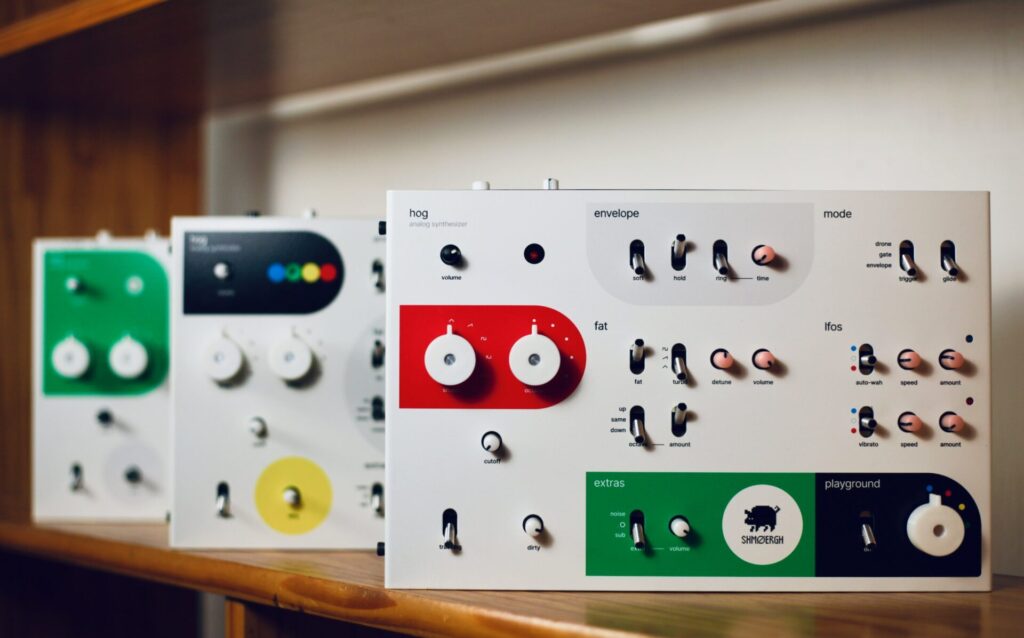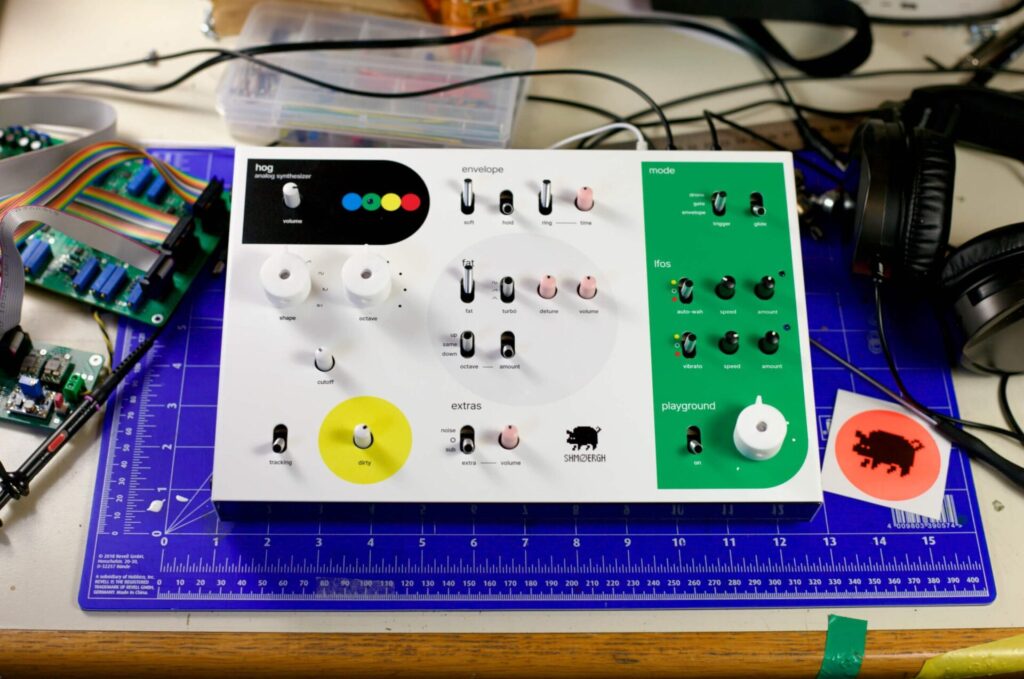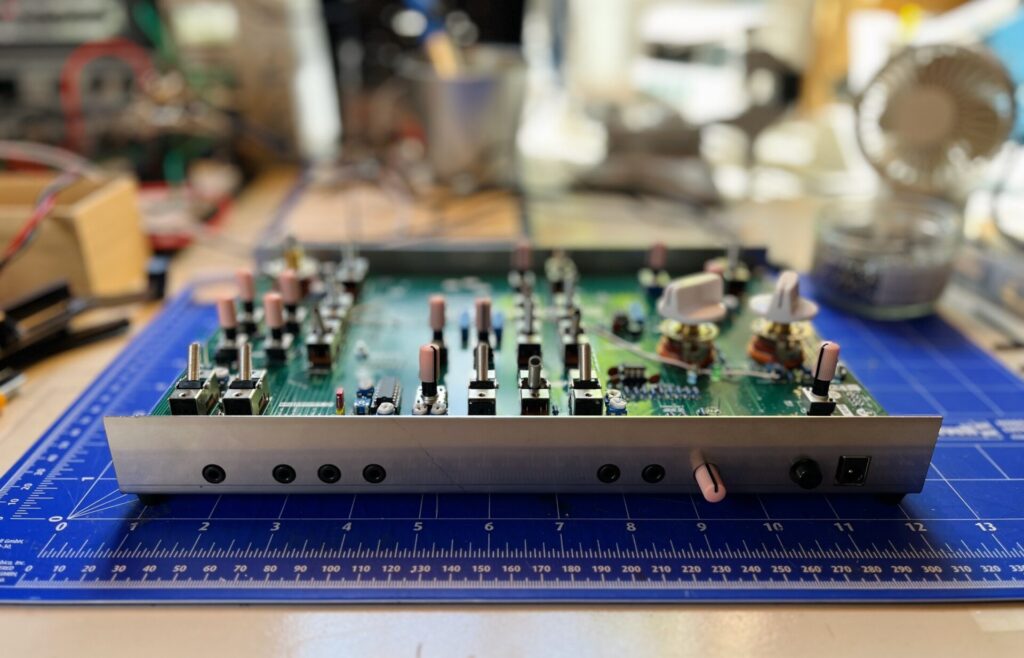Shmoergh Hog is a new two-voice analog monophonic (paraphonic) Synthesizer with cross-mod options and both open-source hard- and software.
We live in a colorful, free world of synthesizers. This is not only the case regarding the designs and feature sets but also how you can buy a synth in 2024. The most traditional and easiest way is to go to a store/online shop like Thomann/Sweetwater… Click here, click there, and the synth will be on your doorstep.
You can also take a much more challenging route by building the synth yourself, the DIY way. Get a ready-packed kit or create one from scratch using only the circuit files. The Hog from Shmoergh is a new open-source analog Synthesizer project that allows you to do just that.
Shmoergh Hog
Important: the Shmoergh Hog is not available on the market. It’s a pure open-source DIY synth project.
Hog is a two-voice analog monophonic Synthesizer with two oscillators. It’s also paraphonic playable via CV. It offers triangle, sawtooth, and square wave shapes. The latter also has a variable pulse width with a narrow option. The second voice also offers a +/- 1/2 octave and detune option for additional voice variation.
Plus, it comes with a sub-oscillator or a noise generator on the second voice. According to the developers, the oscillators have a precision of over 10 octaves, and they can be changed on the hardware with a 5-octave switch.
The so-called playground area hides some great cross-modulation fun. The dedicated switch sends half- or full-amount modulation to the oscillators, filters, and VCA. In the first mode, you can create a hard sync between VCO 2 and VCO1. On top of that, it modulates the pitch of VCO2 via LFO2.
The second mode then modulates the pitch of VCO 1 with the output of VCO 2 to achieve FM sounds. Besides this, you can achieve filter cutoff AM with mode three. Here, it modulates the filter cutoff with the output of VCO 2.
In mode 4, you get VCA (ring) mod by modulating the CV of the VCA with the output of VCO 2. Interesting section with which you can quickly create deeper, harmonic-richer sounds.
From here, it goes into a lowpass-only Steiner-Parker diode filter with cutoff, tracking, and dirty controls. The latter sets the resonance and adjusts the cutoff frequency with the envelope simultaneously. This is an interesting combination, but I always liked the resonance separated on a dedicated control.
Modulation
There is also built-in modulation. First, you get an easy-to-use ADR envelope. According to the developers, the circuit is fully analog, so the attack, release, and decay times have nice exponentials, which result in natural sound. There are various modes, giving you different flavors of envelopes:
- Soft: Turn on for a slightly slower attack
- Hold: When on, the note is held until the key is released on the keyboard
- Ring: If on, the note rings out when the last key is released on the keyboard
- Time: Sets the release/decay time
Next are two triangle LFOs with speed and amount controls for modulating the filter cutoff (auto-wah effects), and/or the pitch of the oscillators (vibrato).
Like in the Roland SH-101, you can experiment with different gate modes: drone keeps the VCA always open and plays the last note from the keyboard, while gate uses the gate voltage to open the VCA.
The envelope mode is the most classic one, using the envelope to open the VCA. Plus, you have the glide, aka portamento option. There are no effects in the initial design, but you can add them anytime since the circuits are open-source and hackable.
The Shmoergh Hog circuit offers MIDI support and is the only digital component of the synth that is also upgradeable. It uses a 3.5 TRS MIDI type A jack, which I would upgrade to a 5-pin if possible.
On the back, Hog offers a +12V DC power supply input, MIDI in on 3.5 jack TRS MIDI type A, a CV input for the cutoff (0-8V), a 1V/oct octave to the VCO 2 CV input for paraphonic use, a gate input (8-12V ), and a stereo output (dual mono line out/headphones).
View this post on Instagram
First Impression
At first glance, a nice open-source DIY synth project. Thanks to the developers who made the project open to everyone. It’s a shame that the synth won’t be released. I would have liked to have seen more analog synths like the Minibrute with the Steiner Parker filter.
Maybe we will see the Hog in a different form in the future.
Shmoergh Hog is now available as an open-source project. The hardware and software sources are on GitHub.







Demos here https://www.instagram.com/p/DB7CNvnKWyb/